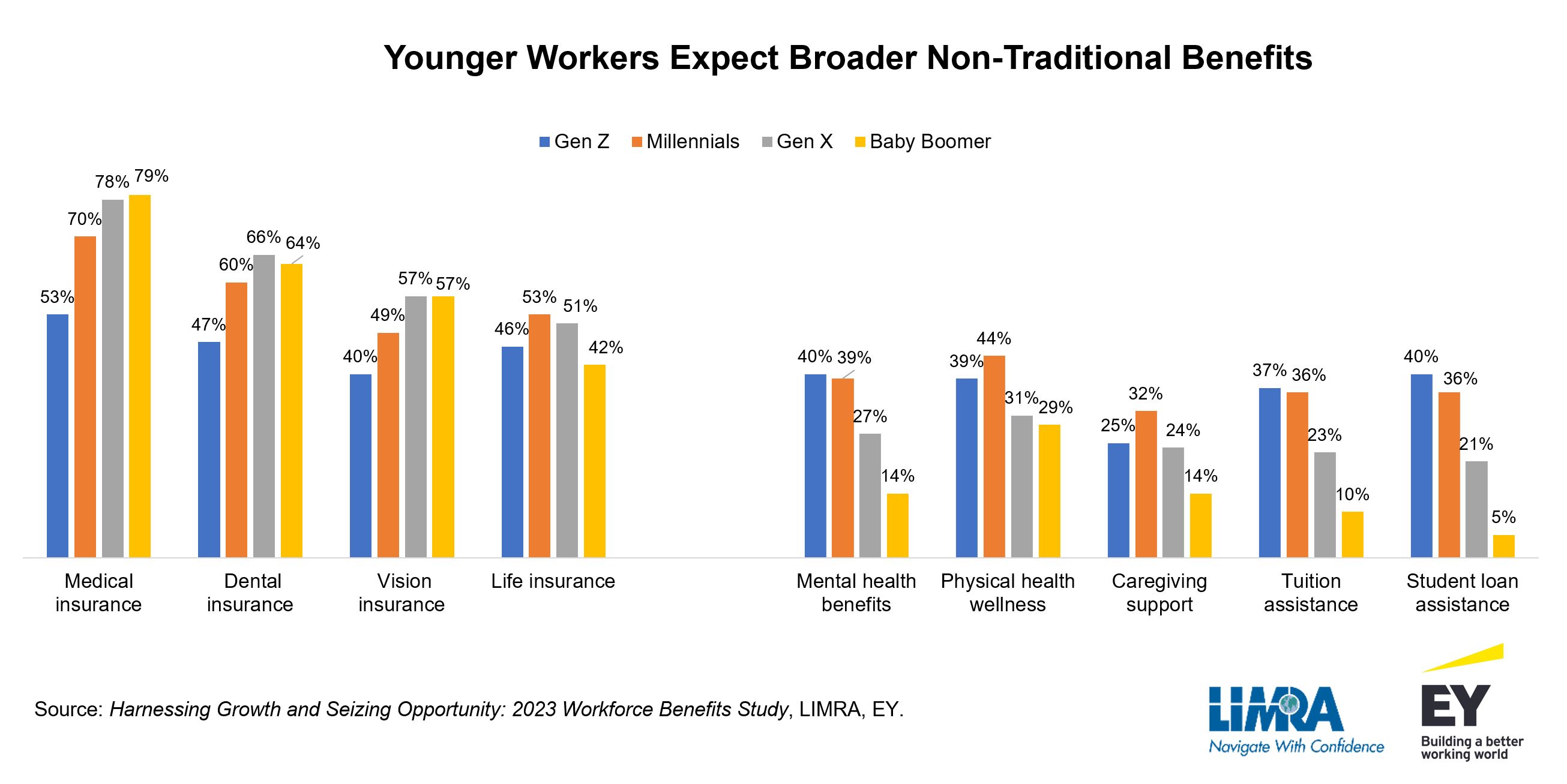The following article was written on 7/31/23 and sourced from LIMRA.com.
LIMRA and EY study recommends employers invest in digitalization to better personalize and deliver benefits for workers of different generations
WINDSOR, Conn., July 31, 2023: With four generations in the workforce, understanding the unique benefits priorities of the various age groups and having the ability to personalize benefits communications and deliverables is key to successfully recruiting and retaining workers.
A new report from LIMRA and Ernst & Young LLP (EY US), Harnessing Growth and Seizing Opportunity: 2023 Workforce Benefits Study, finds a majority of employers (61%) recognize they will need to offer a wider variety of benefit options to meet the expectations of the different generations within their workforce. In particular, employers believe demand for nonmedical benefits, such as paid family medical leave, emergency savings and financial wellness programs, will increase significantly.
“Since the pandemic, employers have faced a dramatically different workforce dynamic with a sustained increase in hybrid and remote workers, which is reshaping expectations,” said Patrick Leary, corporate vice president, head of LIMRA Workplace Benefits Research. “In this highly competitive job market, benefits remain a powerful tool to attract and retain talent. Employers recognize that expanded benefits are key to meeting employees’ post-COVID-19 needs and expectations.”
Benefits Priorities Differ by Generation
LIMRA and EY U.S. employee research confirms that traditional employer-paid products and services will remain at the core of benefits packages, with widespread expectations for more holistic offerings. Most employees expect their employers to provide medical insurance, while paid family leave, dental, vision and life insurance are also highly valued benefits.
The study shows benefits that promote wellbeing, including offerings focused on mental, physical and financial health, have become even more important to younger employees. Younger generations were much more likely to express interest in mental health treatment and physical wellness benefits, tuition and student loan assistance, and caregiving benefits.
“The pandemic expanded employee expectations overall, but more importantly highlighted how a more diverse workforce requires a broader array of benefits. A majority of employers recognize that in the future, it is somewhat or very likely that employees at their company will expect a wider variety of benefits options,” said Chris Morbelli, EY Americas Life and Group Insurance transformation leader. “Employers — particularly smaller organizations — will have to balance building a more comprehensive benefits package with budgetary constraints and will likely look to provide more employee-paid benefits to meet the demand.”
Digitalization Is the Future
Prior LIMRA and EY U.S. research shows one of the biggest challenges for employers is that employees lack an awareness and understanding of the benefits they offer. Given the diverse needs of the workforce, an employer will need to customize communications to effectively engage and educate employees of different generations. Most workers — more than 90% across all generations — feel that guidance can be provided at least somewhat successfully through digital channels. The study finds while all workers are willing to participate digitally, younger generations express the highest interest in using mobile apps for benefits information and tasks. Almost 6 in 10 Gen Z workers and nearly half of Millennial workers (48%) prefer to access their benefits information via mobile apps, compared to less than a quarter of Baby Boomers.
Since most guidance is currently delivered online or through mobile-responsive sites, employers will need to update their technology in the future to accommodate their employees’ preferences. The study shows more than two thirds of employers believe they will rely more heavily on third-party technology in five years, including tools provided by insurance carriers, brokers, technology vendors, and benefits administration and enrollment firms. The study suggests insurance companies will need to ensure their platforms can easily integrate with other vendors to compete for business.
“Digital capabilities are becoming points of differentiation in carrier selection for employers,” said Leary. “When considering a new insurance carrier, 59% of employers say they would select a carrier that works well with their benefits technology platform, even if their product is a little more expensive. Moreover, almost half of employers would switch to a different benefits carrier if that carrier was not integrated to their benefits technology platform.”
To read the full report, visit Harnessing Growth and Seizing Opportunity: 2023 Workforce Benefits Study.



